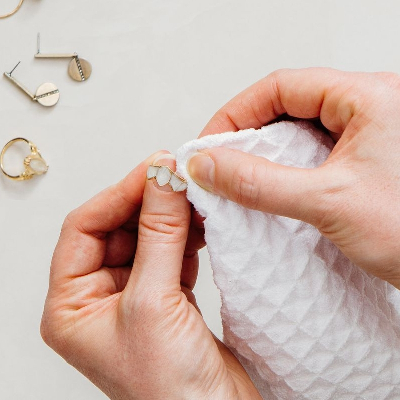Jewelry Care
Everything You Need To Know About How To Clean Piercing Jewelry
People have traditionally used piercings as a common way to express themselves, showing off their individuality and sense of flair. Piercing jewelry, such as nose studs, belly button rings, or classic earrings, gives a fashionable touch to any ensemble. But it's crucial to maintain the cleanliness and condition of your piercing for both style and safety.
In addition to improving your appearance, clean body jewelry is essential for encouraging proper hygiene and averting possible diseases. Unclean jewelry increases the risk of discomfort, allergies, and even serious illnesses because it can harbor germs, dirt, and other impurities.
This post will discuss cleaning various jewelry materials, maintaining piercings, and cleaning jewelry.
When it comes to piercing jewelry, different materials result in a variety of styles and designs. Understanding the variations between these materials is critical, as each requires a unique cleaning procedure.
The following are some common materials used in piercing jewelry:
Titanium: Highly favored for its lightweight nature and biocompatibility, titanium is an excellent option for people with metal sensitivities. It’s also known for its strength and durability, making it a preferred choice for body piercings.
Gold: Gold jewelry adds a touch of luxury to piercings. Gold jewelry is available in different karats, with 14K and 18K being the most common for piercings. Note that higher-karat gold may be softer and more prone to scratches.
Acrylic and bioplast: These materials are common for temporary or healing multiple piercings. Acrylic is lightweight and available in a wide range of colors and styles. Bioplast is a flexible and biocompatible material that reduces the risk of irritation.
How To Clean Piercing Jewelry: Preparation

Before beginning the cleaning process, it is critical to conduct necessary preparation and safety precautions to ensure an effective and sanitary cleaning routine.
Here are some important measures to follow:
- Wash your hands thoroughly: Begin by washing them with soap and water for at least 20 seconds. This helps to eliminate any dirt, bacteria, or pollutants from your hands that may transfer to the jewelry during cleaning.
- Create a tidy workspace: Create a clean and orderly workspace where you can easily clean your piercing jewelry. Ensure that the area is free of dust, grime, and other potential contaminants.
- Remove jewelry from the piercing site: If your jewelry is detachable, remove it before washing. This enables for a more complete cleaning operation and keeps cleaning materials from becoming stuck in the piercings.

How To Sterilize Piercing Jewelry
Different types of piercing jewelry require specific cleaning methods to ensure sterilization and preservation.
Here are the recommended cleaning techniques for some of the most popular piercing jewelry materials:
- Titanium jewelry: It often requires only a mild washing with antibacterial soap and warm water. To remove debris or residue, use a clean, soft cloth or brush. Rinse the jewelry well and dry it with a paper towel.
- Gold jewelry: Sterilize it in the same way that you would stainless steel or titanium. However, to keep the gold's shine, avoid using abrasive items that may scratch the surface. Instead, use a delicate jewelry cleaning cloth or a combination of mild antibacterial soap and hot water.
- Acrylic and bioplast jewelry: If you want to sterilize body jewelry made from acrylic or bioplast, you must take extra care to prevent damage. Avoid harsh chemicals or alcohol-based solutions, as they can cause discoloration or deterioration. Clean these types of jewelry by gently wiping them with a soft, damp cloth.
The procedures described in this tutorial are alternatives to utilizing an autoclave or an ultrasonic cleaner. Both of these instruments are utilized in professional settings, but there's no need to hurry to the store and get one of these gadgets because there are numerous alternative ways to clean your body piercings.
General Cleaning Solutions and Techniques
While mild soap and warm water are suitable for most piercing jewelry, you can use other cleaning solutions and techniques, too.
- Using mild soap and warm water: Prepare a mixture of mild, fragrance-free antibacterial soap and warm water in a spray bottle. Gently scrub the jewelry with a soft cloth or a soft toothbrush. Rinse thoroughly under warm water to remove any soap residue and air dry.
- Soaking in a saline solution: Dissolve non-iodized sea salt or a saline solution specifically made for body piercings in boiling water. Submerge the jewelry in the solution for a few minutes, allowing it to soak. Rinse the jewelry with clean water and pat dry with a paper towel.
Keeping Piercings Clean and Preventing Infection
Establishing a regular cleaning practice will help to keep your piercing jewelry clean and prevent infections. Consistency is essential for maintaining proper hygiene. Remember to clean your new jewelry before wearing it for the first time.
To protect yourself from irritation and infections, keep the following tips in mind.
- Avoid harsh chemicals
- When cleaning jewelry, do not use strong chemicals or abrasive cleaning procedures. These can scratch the jewelry's surface or irritate your skin. Professionals recommend using mild, antibacterial soap, a saline solution, or specialized jewelry cleaning treatments.
- Proper Storage for Piercing Jewelry
- Proper storage is vital for avoiding contamination and damage. When not in use, store your body jewelry in a clean, dry container or jewelry box.
- When to Get Professional Help or Advice
- If you see any signs of infection, such as increased redness, swelling, discomfort, discharge, or fever, get medical attention immediately. A licensed piercer or healthcare expert can evaluate your problem, provide suitable treatment, and provide advice on how to care for your pierced jewelry.
Frequently Asked Question (FAQ)
How to sanitize jewelry without using surgical equipment?
To sanitize jewelry without using medical equipment, soak it in hot water for at least 10 minutes or clean it with rubbing alcohol to help disinfect it. Before employing these methods, make sure the jewelry material is heat or alcohol resistant.
How to clean body jewelry using an ultrasonic cleaner?
To clean body jewelry using an ultrasonic cleaner, first remove any removable parts and place the item in the cleaner's basket. Fill the cleaner with an appropriate cleaning solution, such as mild soap and water. To remove dirt and debris from the jewelry, run the ultrasonic cleaner for the prescribed period, which is normally a few minutes.

